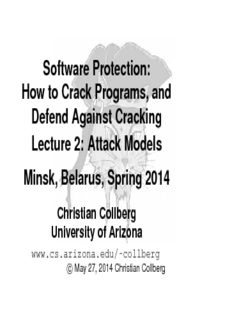
How to Crack Programs, and Defend Against Cracking Lecture 2 PDF
Preview How to Crack Programs, and Defend Against Cracking Lecture 2
Software Protection: How to Crack Programs, and Defend Against Cracking Lecture 2: Attack Models Minsk, Belarus, Spring 2014 Christian Collberg University of Arizona www.cs.arizona.edu/˜collberg (cid:13)c May27,2014ChristianCollberg Last week’s lecture 1 Give an example of a software protection scenario! 2/79 Last week’s lecture 1 Give an example of a software protection scenario! 2 What does MATE stand for? 2/79 Last week’s lecture 1 Give an example of a software protection scenario! 2 What does MATE stand for? 3 What is obfuscation? 2/79 Last week’s lecture 1 Give an example of a software protection scenario! 2 What does MATE stand for? 3 What is obfuscation? 4 What are the three kinds of obfuscating transformations? 2/79 Last week’s lecture 1 Give an example of a software protection scenario! 2 What does MATE stand for? 3 What is obfuscation? 4 What are the three kinds of obfuscating transformations? 5 What is tamperproofing? 2/79 Last week’s lecture 1 Give an example of a software protection scenario! 2 What does MATE stand for? 3 What is obfuscation? 4 What are the three kinds of obfuscating transformations? 5 What is tamperproofing? 6 What two actions make up a tamperproofing algorithm? 2/79 Last week’s lecture 1 Give an example of a software protection scenario! 2 What does MATE stand for? 3 What is obfuscation? 4 What are the three kinds of obfuscating transformations? 5 What is tamperproofing? 6 What two actions make up a tamperproofing algorithm? 7 Give an example of a tamperproofing algorithm! 2/79 When? Where? Why? We now meet Wednesday 1 18:30 Π We meet in Auditorium -13 2 (1st floor) Please check the website for 3 important announcements: www.cs.arizona.edu/˜collberg/ Teaching/bsuir/2014 3/79 Today’s lecture Attack models 1 Constructing attack trees 2 Cracking binaries 3 4/79
Description: